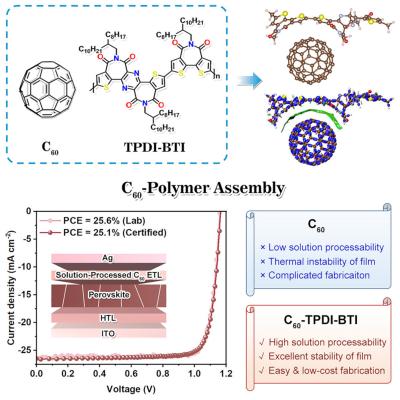An international team, including researchers from EPFL, CNR SCITEC, Fujian Normal University, Southern University of Science and Technology (SUSTech) and others, has used an n-type polymeric additive to stabilize C60 molecules for use in inverted perovskite solar cells. The researchers reportedly designed a solar cell with the highest efficiency value ever recorded for perovskite devices based on solution processed C60 electron transport layers.
The team explained that C60 is currently the best-performing type of ETL for perovskite solar cells, although it suffers from “significant” aggregation in solution, which makes a high-cost and complex thermal evaporation method necessary for its development. To solve this issue, it utilized an n-type polymeric additive to stabilize C60 molecules for solution processing. “We introduced an n-type polymeric additive, TPDI-BTI, constructed from the strongly electron-deficient dithienylpyrazinediimide (TPDI) and the imide-functionalized bithiophene (BTI) co-unit and applied it into the C60 ETLs,” the researchers explained. “By controlling the TPDI-BTI addition, we can systematically regulate the ETLs, including film formability and morphological stability, energy levels and electron transport dynamics, intermolecular interacting behaviors and interfacial contacts, and finally, the photovoltaic performance and long-term stability of the cells.”
After calibrating the new ETLs, the research team built a solar cell with a substrate made of indium tin oxide (ITO), a hole transport layer (HTL) made of nickel(II) oxide (NiOx) and phosphonic acid called methyl-substituted carbazole (Me-4PACz), a perovskite absorber, the optimized C60 ETL, a tin oxide (SnOx) buffer layer, a bathocuproine (BCP) buffer layer, and a silver (Ag) metal contact.
Tested under standard illumination conditions, the device achieved a maximum power conversion efficiency of 25.60%, which the scientists said is the highest value ever reached for inverted perovskite solar cells based on solution-processed (SP) C60 ETLs. The cell also showed “superior” stability under continuous light illumination for 1,800 h and at high temperature for 700 h.
“This work demonstrates the great potential of C60-polymer mixed ETLs for the development of low-cost, highly efficient, and stable fully solution-processed perovskite solar cells,” the research team concluded.


